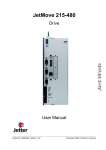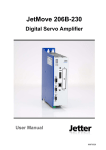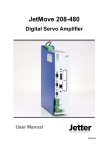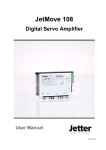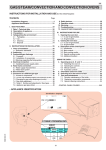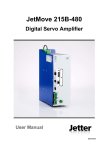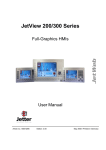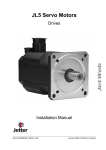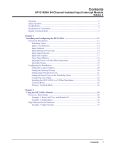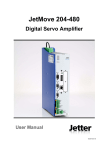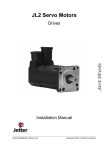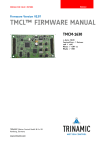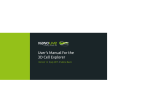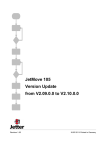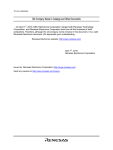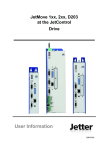Download JetMove 203-230 User Manual Edition 1.10
Transcript
JetMove 203-230 JetWeb Drive User Manual Article # 60865160 / Edition 1.10 November 2006 / Printed in Germany Introduction JetWeb Edition 1.10 Jetter AG reserves the right to make alterations to its products in the interest of technical progress. These alterations need not be documented in every single case. This manual and the information contained herein have been compiled with due diligence. Jetter AG shall not be liable for errors contained herein or for incidental or consequential damage in connection with the furnishing, performance, or use of this material. The brand names and product names used in this manual are trade marks or registered trade marks of the respective title owner. 2 Jetter AG JetMove 203-230 Introduction How to Contact Us Jetter AG Gräterstraße 2 D-71642 Ludwigsburg Germany Switchboard: Sales: Phone - Technical Hotline: 07141/2550-0 07141/2550-433 (+49) 7141/2550-444 Fax - Sales: E-Mail - Sales: E-Mail - Technical Hotline: Internet Address: (+49) 7141/2550-484 [email protected] [email protected] http://www.jetter.de This User Manual is an Integral Part of the JetMove 203-230: Type: Serial No.: Year of Manufacture: Order No: To be entered by the customer: Inventory No: Place of operation: © Copyright 2006 by Jetter AG. All rights reserved. Jetter AG 3 Introduction JetWeb Significance of this Operator's Manual This operator's manual is an integral part of the digital servo amplifier JetMove 203-230 and • • must be kept in a way that it is always at hand until the the digital servo amplifier JetMove 203-230 will be disposed of. Pass this manual on if the digital servo amplifier JetMove 203-230 is sold or loaned/leased out. In any case you encounter difficulties to clearly understand the manual, please contact the manufacturer. We would appreciate any kind of suggestion and contributions on your part and would ask you to inform us or to write us. This will help us to produce manuals that are more user-friendly and to address your wishes and requirements. This manual contains important information on how to transport, erect, install, operate, maintain and repair the digital servo amplifier JetMove 203-230. Therefore, the persons carrying out these jobs must carefully read, understand and observe this manual, and especially the safety instructions. Missing or inadequate knowledge of the manual results in the loss of any claim of liability on part of Jetter AG. Therefore, the operating company is recommended to have the instruction of the persons concerned confirmed in writing. History 4 Edition Comment 1.00 First edition 1.10 Revisions, see Appendix A: "Recent Revisions", page 81 of edition 1.10 Jetter AG JetMove 203-230 Introduction Description of Symbols This sign is to indicate a possible impending danger of serious physical damage or death. Warning This sign is to indicate a possible impending danger of light injury. This sign is also to warn you of material damage. Caution This sign indicates hazard of life due to electric shock caused by a high operating voltage. This sign is to indicate hazard of serious physical damage or death due to accidentally touching dangerous parts of the device. Important This sign is to indicate a possible impending situation which might bring damage to the product or to its surroundings. This symbol also points to conditions, which must by all means be given heed to, in order to guarantee faultless functioning. You will be informed of various possible applications and will receive further useful suggestions. Further, it points to tipps and advice for efficient use of the device and for optimization of the corresponding software, in order to save you extra work. Note ·/- Enumerations are marked by full stops, strokes or scores. Operating instructions are marked by this arrow. Automatically running processes or results to be achieved are marked by this arrow. Jetter AG 5 Introduction JetWeb PC and user interface keys. This symbol refers to further information (data sheets, literature, etc.) on the subject or product or the like that is being dealt with. Further, this text provides helpful hints for your guidance through the manual. 6 Jetter AG JetMove 203-230 Table of Contents Table of Contents Jetter AG 1 Safety Instructions 9 1.1 General Information 9 1.1.1 1.1.2 1.1.3 1.1.4 1.1.5 1.1.6 Usage as agreed upon Usage other than agreed upon Who may operate the servo amplifier JetMove 203-230? Modifications and alterations to the module Repairs and servicing of the JetMove 203-230 Decommissioning and disposing of the JetMove 203-230 9 9 10 10 10 11 1.2 Ensure your Own Safety 12 1.2.1 1.2.2 1.2.3 Malfunctions Information signs and labels Earthing procedure 12 12 13 1.3 Residual Dangers 15 1.3.1 1.3.2 Hazards during operation Hazards after POWER is turned OFF 15 17 1.4 Instructions on EMI 18 2 Installing the JetMove 203-230 21 2.1 Scope of Delivery 21 2.2 Mechanical Installation 22 2.3 Electrical Installation 24 2.4 Checking the Installation 25 2.5 Notes on Safety as regards the Installation 25 2.6 Safety Instructions for Commissioning 26 3 Operating Conditions 27 4 Physical Dimensions 33 5 Technical Data 35 5.1 Electrical Specification 35 5.2 Motor Protection 39 5.2.1 5.2.2 5.2.3 Thermal sensor integrated in the motor I²t calculation Motor overload calculation according to UL 39 39 41 6 Drive Controller Structure 43 7 Description of Connections 45 7.1 Power Supply 45 7.2 Motor Connection 47 7 Inhalt JetWeb 7.2.1 7.2.2 7.2.3 7.2.4 General remarks Assignment and specification Motor power cable with mating connector SC Connection assignment of terminal box 47 48 49 52 7.3 Connection of the Resolver 52 7.3.1 7.3.2 Specification Resolver cable with mating connector 52 53 7.4 HIPERFACE Connection 55 7.4.1 7.4.2 Specification HIPERFACE cable with mating connector 55 55 7.5 Digital Inputs, Logic Power Supply 58 7.6 Jetter System Bus 60 7.6.1 Specification of the Jetter system bus cable 60 8 Status Monitoring 63 9 Diagnostics 65 9.1 Error Messages 65 9.2 WARNINGS 69 10 Wiring Diagrams 71 11 Analog Input (Option) 77 11.1 Function 77 11.2 Technical Data 77 11.3 Description of Connections 78 List of Appendices Appendix A: Appendix B: Appendix C: Appendix D: 8 Recent Revisions Glossary List of Illustrations Index 81 83 86 87 Jetter AG JetMove 203-230 1.1 General Information Table Contents of 1 1.1 Safety Instructions General Information The digital servo amplifier JetMove 203-230 fulfils the accepted safety regulations and standards. Special emphasis was given to the safety of the users. The following additional regulations apply to the user: • relevant accident prevention regulations; • accepted safety rules; • EC guidelines and other country-specific regulations. 1.1.1 Usage as agreed upon Usage as agreed upon includes operation in accordance with these operating instructions. The digital servo amplifier JetMove 203-230 may only be operated in the closed control cabinet and within the range of the set values, see chapter 5 "Technical Data", page 35. Do not apply a voltage to the digital servo amplifier JetMove 203-230 that is higher than the prescribed operating voltage. The operating voltage of the digital servo amplifier JetMove 203-230 ranges between AC 195 V and AC 265 V. Thus, the digital servo amplifier comes under the EC Low Voltage Directive. It is the explicitpurpose of the servo controller JetMove 203-230 to torque-, speed- and/or position-control, and to drive brushless synchronous servo motors. The winding isolation of the motors must be higher than, or at least equal to, the DC link voltage supplied by the servo amplifier. The digital servo amplifier JetMove 203-230 is used to control machinery, such as conveyors, production machines, and handling machines. 1.1.2 Usage other than agreed upon The digital servo amplifier must not be used in technical systems which to a high degree have to be fail-safe, e.g. ropeways and aeroplanes. If the digital servo amplifier JetMove 203-230 is to be run under operating conditions, which differ from the conditions mentioned in chapter 3 "Operating Conditions", page 27, the manufacturer is to be contacted beforehand. Jetter AG 9 1 Safety Instructions JetWeb 1.1.3 Who may operate the servo amplifier JetMove 203-230? Only instructed, trained and authorised persons are permitted to operate the servo amplifier JetMove 203-230. Transport: Only by personnel with knowledge in handling electrostatically sensitive components. Installation: Only by specialists with training in electrical engineering. Commissioning: Only by specialists with extensive knowledge of and experience with electrical engineering / drive technology. 1.1.4 Modifications and alterations to the module Due to safety reasons, no modifications and alterations to the digital servo amplifier JetMove 203-230 and its functions are allowed. Any modifications to the servo amplifier JetMove 203-230 not expressly authorised by the manufacturer will result in a loss of any liability claims to Jetter AG. The original parts are specifically designed for the servo amplifier JetMove 203-230. Parts and equipment of other manufacturers are not tested on our part, and are therefore not released by us. The installation of such parts may impair the safety and the proper functioning of the digital servo amplifier JetMove 203-230. From any damages resulting from usage other than agreed upon, e.g. the use of nonoriginal parts and equipment, any claims with respect to the liability of Jetter AG are excluded. 1.1.5 Repairs and servicing of the JetMove 203-230 Repairs at the digital servo amplifier JetMove 203-230 must not be carried out by the operator. The servo amplifier JetMove 203-230 does not contain any parts to be repaired by the operator. For being repaired, the servo amplifier JetMove 203 -230 must be sent to Jetter AG. The digital servo amplifier JetMove 203-230 is maintenance-free. Therefore, no inspection or maintenance is required for the operation of the module. 10 Jetter AG JetMove 203-230 1.1 General Information 1.1.6 Decommissioning and disposing of the JetMove 203-230 The environmental regulations for the respective country apply to decommissioning and disposing of the digital servo amplifier on the operating company’s premises. You can disassemble the servo amplifier JetMove 203-230 into its main components by unscrewing it (aluminium heat sink and side plate, steel casing cover, electronic boards). Jetter AG 11 1 Safety Instructions JetWeb 1.2 Ensure your Own Safety Isolate the digital servo amplifier JetMove 203-230 from the mains, if maintenance works have to be carried out. By doing so, you will prevent accidents resulting from electric voltage and moving parts. Please note chapter 1.3 "Residual Dangers", page 15. Warning Safety and protective devices, e.g. the barrier and cover of the terminal box or the thermal motor circuit-breaker must not in any case be shunted or by-passed. Dismantled protective equipment, such as the fuses and the thermal motor circuit-breakers, must be reattached prior to commissioning and checked for proper functioning. Before commissioning, the machine manufacturer must carry out a hazard analysis of the respective machine and take adequate measures so that inadvertent motions will not lead to personal injury and to material damage. 1.2.1 Malfunctions In the case of malfunctions or other faults, please immediately separate the digital servo amplifier JetMove 203-230 from the mains. Please note chapter 1.3 "Residual Dangers", page 15. Malfunctions or other damages are to be reported to an authorized person immediately. Secure the servo amplifier JetMove 203-230 against misuse or accidental use. 1.2.2 Information signs and labels Writings, information signs, and labels always have to be observed and kept readable. Damaged or unreadable information signs and labels are to be exchanged. 12 Jetter AG JetMove 203-230 1.2 Ensure your Own Safety 1.2.3 Earthing procedure Screw the enclosure of the digital servo amplifier JetMove 203-230 onto a highly conducting, earthed panel. Do only use the servo amplifier JetMove 203-230 at the three-phase, earthed industrial network (TN network, TT network with earthed neutral, 5,000 A max, symmetric rated current at 400 / 480 V + 10 %). The servo amplifier must not be operated when connected to unearthed networks and to unsymmetrically earthed networks. One-phase connection to this power supply is only possible via one mains phase and the neutral conductor. Der drei-phasige Anschluss darf nur über einen Tenn- oder Spartransformator vorgenommen werden, (siehe auch chapter "Connection type of the voltage supply", page 35 und chapter 10 "Wiring Diagrams", page 71). The digital servo amplifier JetMove 203-230 has got a leakage current greater than 3.5 mA. In order to avoid electric shocks, a second protective earth conductor will be required. For this, the following measures must be taken: • The PE must be connected to the bolt (1) located at the top side of the rack, as well as to the PE terminal X1 (2); for this, please refer to 1. The cross-sectional area of the two earthing conductors must be equal to the cross-sectional area of the supply lines (1.5 mm2 min.): • A durable connection with the power supply of the digital servo amplifier JetMove 203-230 must be provided. • Correct cabling of the PE bus according to the connection diagram (cf. chapter 10 "Wiring Diagrams", page 71) must be carried out. Jetter AG 13 1 Safety Instructions JetWeb 2 1 View X Jetter U1 V1 W1 PE 3 x AC 230 V JetMove 203-230 BUS-IN X1 1 5 V2 U2 PE 9 Motor 6 X18 W2 BUS-OUT 6 X62 9 5 1 X19 BRAKE 2 BRAKE 1 ENCODER DC 24 V 0,6 A 6 ⊥ ⊥ INPUT REF LIMIT LIMIT + ENABLE 5 1 X71 X10 9 X61 X Fig.1: Double earthing Important! Do not loop an earth-leakage current breaker into the mains power supply. Using an earth-leakage current breaker (FI) looped into in the mains power supply is not possible. If, in spite of this, an earth-leakage current breaker is installed, it will switch off the digital servo amplifier JetMove 203-230, although there is no fault. When a leakage current screen needs to be installed in the JetMove 203-230, an isolating transformer must be used. 14 Jetter AG JetMove 203-230 1.3 Residual Dangers 1.3 Residual Dangers 1.3.1 Hazards during operation HAZARD caused by high operating voltage! Extremely hazardous voltages of up to DC 480 V may occur! Warning These voltages lead to muscle cramps, burns, unconsciousness, respiratory standstill, and death. During operation, all coverings and control cabinet doors must be kept closed. Do not open the device. Do by no means disconnect the electric connections of the servo amplifier JetMove 203-230 when it is live. During operation, do not touch the screws of field wiring terminals X1 and X62. In the given context, the terminals have the following meaning: X1: AC 230 V supply voltage X62: DC Motors voltage of up to 480 V Warning DANGER of hot surfaces! During operation, the surfaces, respectively the heat sinks of the servo amplifier JetMove 203-230 can heat up. The internal heat sink can reach temperatures of up to 90 °C. Caution Do by no means touch the enclosure of the digital servo amplifier JetMove 203-230 near the internal heat sink during operation and during the cooling-off period after switching off the device. Please make sure that no temperature-sensitive parts have been connected or fastened to the servo amplifier JetMove 203-230. Jetter AG 15 1 Safety Instructions JetWeb DANGER in potentially explosive atmosphere! Do not operate the digital servo amplifier JetMove 203-230 in a potentially explosive atmosphere. Warning DANGER of injuries caused by mechanic force! Caution The digital servo amplifier JetMove 203-230 runs a servo motor. This servo motor moves mechanic parts or sharp edges. Therefore, failure or malfunctioning of the digital servo amplifier JetMove 203-230 can be dangerous for a person or damage the manufacturing plant to an amount depending on the respective kind of plant. This should be prevented by installing additional safety precautions. • One safety precaution is to install a second set of limit switches to interrupt the power supply of the motor. • Another safety precaution would be to install a protection cover. Make sure that hazards to persons are precluded even when the drive is moving unintentionally. Do not dismount any necessary protective covers. Do not wear gloves, lest they should get caught in the rotating drive shaft. Warning 16 Never touch a rotating drive shaft. Jetter AG JetMove 203-230 1.3 Residual Dangers 1.3.2 Hazards after POWER is turned OFF DANGER resulting from electric shock! Capacitors installed in the servo amplifier can still have dangerous voltages present up to five minutes after switching off the supply voltages. Warning Always wait at least 5 minutes after switching off the device, before separating it from the mains or loosening the connections. Always wait at least 10 minutes after switching off the device before taking the following actions: – Touching the screws of the terminals X1 and X62; – Disconnecting the terminals and touching the contacts. Jetter AG 17 1 Safety Instructions JetWeb 1.4 Instructions on EMI The digital servo amplifier JetMove 203-230 is intended for use in industrial surroundings. It can cause radio interferences in residential areas. It is operated at the operator's own risk. The noise immunity of a system corresponds to the weakest component of the system. For this reason, correct wiring and shielding of the cables is important. Important! Measures for increasing immunity to interfering in electric plants: Earth the device adequately according to chapter 1.2.3 "Earthing procedure", page 13. Connect all grounding terminals of the JetMove 203-230. A double grounding terminal will be needed! – Connect the protective earth terminal located on the enclosure – Connect the protective earth (PE) conductor to terminal X1. see Fig. 1 on page 14 Connect the motor lines. An optional mains filter must be as close to the servo amplifier as possible. Both sides of the cable must be shielded. If a motor power cable is used which includes cores for brake control, the brake control cores must be separately shielded. Earth the shielding at both ends. The shielding braid must be placed on both ends of the applicable cables. The distance between the optional line filters and the servo amplifier JetMove 203-230 must be kept as short as possible. Please follow the instructions given in Application Note 016 "EMCCompatible Installation of the Electric Cabinet" published by Jetter AG. The following instructions are excerpts from Application Note 016: Screw the enclosure of the digital servo amplifier JetMove 203-230 onto a highly conducting, earthed panel. On principle, physical separation should be maintained between signal and power lines. We recommend spacings greater than 20 cm. Cables and lines should cross each other at an angle of 90°. 18 Jetter AG JetMove 203-230 1.4 Instructions on EMI Shielded cables must be used for the following lines: Analog lines, data lines, motor cables coming from inverter drives (servo output stage, frequency converter), lines between components and interference suppressor filter, if the suppressor filter has not been placed at the component directly . Shield both sides of the cable. Unshielded wire ends of shielded cables should be as short as possible. The entire shield must be drawn behind the isolation, and then be extensively clamped under a flat earthed strain relief. If male connectors are used: The shield (impedance shielding) must, in its entire perimeter, be drawn behind the shielding clamp of the metallised connector housing, respectively of the EMC gland bushing, its greatest possible surface area being clamped under a strain relief. Only use metallised connectors, e.g. SUB-D with metallised housing. Make sure that the strain relief is directly connected with the housing here as well (see Fig. 2). Fig.2: Shielding of SUB-D connectors in conformity with EMC standards. What to do, if the shield cannot be fixed to the connector, e.g. if the signal has been connected to terminal screws: Shield and cable strap must be connected with low impedance to earthed surfaces. Earthing must be done in a way that keeps the unshielded part of the signal lines as short as possible (see Fig. 3). Jetter AG 19 1 Safety Instructions Cable Strap max. 1 m Mating Connector m JetWeb Motor Cable Fig.3: EMC-conformous shielding for terminal screws 20 Jetter AG JetMove 203-230 2.1 Scope of Delivery 2 Installing the JetMove 203-230 2.1 Scope of Delivery • • • • Digital servo amplifier JetMove 203-230 Mating connector, plugged on Cable strap serving as strain relief and motor power cable shield User manual Accessories The accessories are not included in the scope of delivery! • System bus cable of cable confection # 530 x.x m; length: 0.2 m through 5.0 m. Please refer to chapter 7.6 "Jetter System Bus", page 60. • Motor power cable, see chapter 7.2 "Motor Connection", page 47. • Resolver cable; please refer to chapter 7.3 "Connection of the Resolver", page 52. • HIPERFACE cable; please refer to chapter 7.4 "HIPERFACE Connection", page 55. • Motors, e.g. synchronous servo motors of the motor series JK or JL, made by Jetter AG. • Motor circuit-breaker, see chapter 5 "Technical Data", page 35. • Circuit-breaker, see chapter 5 "Technical Data", page 35. • Isolating transformer or autotransformer • Mounting screws, 2 pcs.; please refer to Fig. 4, page 23. Note! If you are not sure which mounting accessories you require, please contact Jetter AG. Jetter AG 21 2 Installing the JetMove 203-230 2.2 JetWeb Mechanical Installation Prior to installing the digital servo amplifier, check it for possible transport damages. Check the shipment for completeness. To ensure proper functioning of the JetMove 203-230 check whether the mounting plate in the electric cabinet is unpainted. The only possible mounting direction is vertical - see Fig. 4, page 23. Please make sure there is a clearance of at least 100 mm under and above the JetMove 203-230 - unobstructed ventilation must be granted. Please mark on the panel two positions for the fastening screw threads of the JetMove 203-230 (see Fig. 4, page 23). Drill the holes and cut the thread into the panel. Screw the corresponding fitting bolts into the thread by approximately half of their length. By means of the oblong holes in the rear plate, hang up the JetMove 203-230 by the fitting bolts; then screw them tightly. 22 Jetter AG JetMove 203-230 2.2 Mechanical Installation 58 219 264 268.8 291.3 239.5 A 70 12 22.8 33.8 8.5 O 5.5 O 5.5 12.5 9 O DETAIL A 4:1 Fig.4: Rear and front view of the enclosure with mounting holes Jetter AG 23 2 Installing the JetMove 203-230 2.3 JetWeb Electrical Installation Check for correct motor and servo amplifier assignment. Compare rated voltage and continuous rated current of servo amplifier and motor. The motor must be isolated against voltages of DC 480 V min.; please also refer to “Compatible Synchronous Servo Motors" on page 39. Connect the JetMove203-230 according to the connection wiring diagram shown in chapter 10 "Wiring Diagrams", page 71. Especially check the power lines for appropriate protection, see “Overload protection" on page 35. Protecting the motor cables is not advisable. Select the cables according to standards. Verify that all earthing cables are connected (double earthing). To connect resolvers or power units you can use prefabricated cables available from Jetter or opt for self-made cables. Please refer to chapter 7 "Description of Connections", page 45. To ensure that installation is carried out in conformance with EMC regulations, the following items have to be observed especially: – If possible, run control cables and power cables separately; – Connect resolver; – Use shielded terminals or EMC-compatible connectors; – Connect holding brake, if available, and connect shields on both sides of the cables; – Connect the motor leads according to Fig. 3. Please further note the chapter 1.4 "Instructions on EMI", page 18. 24 Jetter AG JetMove 203-230 2.4 Checking the Installation 2.4 Checking the Installation Check motor and servo amplifier wiring and connections by means of the connection diagrams used. Check the holding brake, if existing, for proper functioning. Check to see whether all necessary protection measures against accidental contact with live or moving parts have been taken. Carry out any other checks specific to, or required, for your system. 2.5 Notes on Safety as regards the Installation HAZARD caused by high operating voltage and electric shock! Extremely hazardous voltages of up to DC 480 V may occur! Warning Please observe the following precautions in order to avoid muscle cramps, burns, unconsciousness, respiratory standstill, etc., and death: Have installation and maintenance jobs carried out by qualified personnel only, see chapter 1.1.3 "Who may operate the servo amplifier JetMove 203-230?", page 10. Switch off the operating voltage. Consider the warnings of residual dangers in chapter 1.3.2 "Hazards after POWER is turned OFF", page 17. Before carrying out installation and maintenance jobs, separate the servo amplifier JetMove 203-230 and all connected devices from the mains (pull out the mains plug). Jetter AG 25 2 Installing the JetMove 203-230 2.6 JetWeb Safety Instructions for Commissioning HAZARD caused by high operating voltage and electric shock! Extremely hazardous voltages of up to DC 480 V may occur! Warning Please observe the following precautions in order to avoid muscle cramps, burns, unconsciousness, respiratory standstill, etc., and death: Have commissioning jobs carried out by qualified personnel only, see chapter 1.1.3 "Who may operate the servo amplifier JetMove 203-230?", page 10. Before switching on Reattach dismantled protective equipment and check it for proper functioning. By doing so, you will prevent accidents resulting from movable parts. Secure the servo amplifier JetMove 203-230 against accidental contact with conductive parts and components. Only connect devices or electrical components to the signal lines of the digital servo amplifier JetMove 203-230 (Enable, Limit+/-, REF, BRAKE 1 and BRAKE 2) that have been sufficiently isolated against the connected electric circuits. These signal lines may only be connected with units that have got the ground potential of the DC 24 V power supply. Accordingly, do only connect resolver, HIPERFACE and servo motor with the servo amplifier, if they have been sufficiently isolated from the connected power supply. The digital servo amplifier JetMove 203-230 has got a leakage current greater than 3.5 mA. In order to avoid electric shocks, a second protective earth conductor will be required. For this, the measures listed in chapter 1.2.3 "Earthing procedure", page 13 must be taken. Each commissioning, even a short functional test, must always be carried out with a PE bus correctly connected. 26 Jetter AG JetMove 203-230 3 Operating Conditions Operating Parameters Connected Load Parameters Value(s) Connected load Switching device: 3 * AC 230 V, 50 / 60 Hz (AC 195 V through AC 265 V) Standard Specification(s) Referred to Logic part: DC 24 V, SELV / PELV <= 0.6 A (DC 20 V through DC 30 V) Supply fluctuations Speed of changing the frequency: 2 %/s max. Voltage imbalance: 2 % max. Voltage dips: 3 ms max. Operating Parameters Environment Jetter AG Parameters Value(s) Standard Specification(s) Referred to Operating conditions Temperature: 0 °C to +45 °C (+45 °C to +55 °C: Derating 2.5 %/ K) Air humidity: 5 % to 85 %, non-condensing DIN EN 50178 Storage conditions (units within packing) Temperature: -25 °C to +55 °C, Maximum fluctuation: 20 K/h Air humidity: 5 % to 95 %, non-condensing Maximum storage period: < 1 year without restrictions DIN EN 50178 Transport conditions (units within packing) Temperature: -25 °C to +70 °C Air humidity: 5 % to 95 %, non-condensing DIN EN 50178 Pollution degree 2 DIN EN 50178 Corrosion immunity / Chemical resistance No special protection against corrosion. Ambient air must be free from higher concentrations of acids, alcaline solutions, corrosive agents, salts, metal vapours, or other corrosive or electroconductive contaminants - 27 3 Operating Conditions JetWeb Operating Parameters Environment Operating altitude 1,000 m max. above sea level From 1,000 to 2,500 m above sea level; derating 1.5 % per 100 m increase in alitude DIN EN 50178 Operating Parameters Mechanical Parameters Parameters Value(s) Standard Specification(s) Referred to Transport stability Within original packing, the device withstands dropping over all of its edges DIN EN 50178 DIN EN 60068-2-31 Vibration resistance • DIN EN 50178 DIN EN 60068-2-6 • • 10 Hz - 57 Hz: 0.075 mm amplitude 57 Hz - 150 Hz: 1.0 g constant acceleration 1 octave per minute, 10 frequency sweeps (sinusoidal), all three spatial axes Degree of protection IP 20 Mounting position Vertical Please make sure there is a clearance of at least 100 mm under and above the JetMove 206B-230 - sufficient ventilation must be granted. DIN EN 60529 Important! Measures to avoid damages in transit and storage: The packaging material and the storage place are to be chosen in a way that the values given in the above table “Operating Parameters Mechanical Parameters" on page 28 are kept to. 28 Jetter AG JetMove 203-230 Operating Parameters Electrical Safety Parameters Value(s) Standard Specification(s) Referred to Protection class I DIN EN 50178 Dielectric strength Protective network conductor and network logics: 1.7 kV, 5 s DIN EN 50178 DIN EN 60204-1 Insulation Protective network conductor and network logics: > 1 MOhm at 500 V DIN EN 50178 Protective earth connection 12 V, 10 A, 0.1 Ohm DIN EN 60204-1 Overvoltage category III DIN EN 50178 DIN VDE 0110-1 UL 508C Operating Parameters EMI Emitted Interference Parameters Value(s) Standard Specification(s) Referred to Enclosure • Frequency band 30 - 230 MHz, limit 30 dB (µV/m) in 30 m • Frequency band 230 - 1000 MHz, limit 37 dB (µV/m) in 30 m (First surroundings, restricted availability) DIN EN 61800-3 Alternating network current Frequency band: • 0.15 - 0.5 MHz, limit 79 dB (µV)* • 0.5 - 30 MHz, limit 73 dB (µV)* * Measuring by means of the quasi-peak detector (First surroundings, restricted availability) DIN EN 61800-3 Important! This is a product of restricted availability according to IEC/EN 61800-3. This module can cause radio interferences in residential areas. In this case, the user must take adequate measures to prevent this. Additional line filters can be helpful here. See "Line filter" on page 36. Jetter AG 29 3 Operating Conditions JetWeb Operating Parameters EMI Immunity to Interference Enclosure Parameters Value(s) Standard Specification(s) Referred to ESD Discharge through air: Test peak voltage 8 kV Contact discharge: Test peak voltage 6 kV Criterion B (Second surroundings, restricted availability) DIN EN 61800-3 DIN EN 61000-4-2 RF field amplitude-modulated Frequency band 80 -1000 MHz; test signal strength 10 V/m AM 80 % with 1 kHz Criterion A (Second surroundings, restricted availability) DIN EN 61800-3 DIN EN 61000-4-3 Operating Parameters EMI Immunity to Interference Power Connections 30 Parameters Value(s) Standard Specification(s) Referred to Burst (fast transients) Test voltage 2 kV Repetition rate 5 kHz Criterion B (Second surroundings, restricted availability) DIN EN 61800-3 DIN EN 61000-4-4 Impulse voltages tr/th 1,2/50 µs, 8/20 µs 1 kV (launching phase conductor against phase conductor) 2 kV (launching phase conductor against ground potential) (Second surroundings, restricted availability) DIN EN 61800-3 DIN EN 61000-4-5 Guided radio disturbances Frequency 0.15 - 80 MHz Test voltage 10 V AM 80 % with 1 kHz Criterion A (Second surroundings, restricted availability) DIN EN 61800-3 DIN EN 61000-4-6 Jetter AG JetMove 203-230 Operating Parameters EMI Immunity to Interference Power Interfaces Parameters Value(s) Standard Specification(s) Referred to Burst (fast transients) Test voltage 2 kV Repetition rate 5 kHz Capacitive interference Criterion B (Second surroundings, restricted availability) DIN EN 61800-3 DIN EN 61000-4-4 Operating Parameters EMI Immunity to Interference Measuring and Control Circuits in Process Environments Parameters Value(s) Standard Specification(s) Referred to Burst (fast transients) Test voltage 2 kV Repetition rate 5 kHz Capacitive interference Criterion B (Second surroundings, restricted availability) DIN EN 61800-3 DIN EN 61000-4-4 Guided radio disturbances Frequency 0.15 - 80 MHz Test voltage 10 V AM 80 % with 1 kHz Criterion A (Second surroundings, restricted availability) DIN EN 61800-3 DIN EN 61000-4-6 Operating Parameters EMI - Immunity to Interference Signal Interfaces Jetter AG Parameters Value(s) Standard Specification(s) Referred to Burst (fast transients) Test voltage 1 kV Repetition rate 5 kHz Capacitive interference Criterion B (Second surroundings, restricted availability) DIN EN 61800-3 DIN EN 61000-4-4 31 3 Operating Conditions JetWeb Operating Parameters EMI - Immunity to Interference Signal Interfaces Guided radio disturbances 32 Frequency 0.15 - 80 MHz Test voltage 10 V AM 80 % with 1 kHz Criterion A (Second surroundings, restricted availability) DIN EN 61800-3 DIN EN 61000-4-6 Jetter AG JetMove 203-230 4 Physical Dimensions Fig.5: Mounting dimensions of the JetMove 203-230 For installation, please also refer to Fig. 4 on page 23 Jetter AG 33 4 Physical Dimensions JetWeb 34 Jetter AG JetMove 203-230 5.1 Electrical Specification 5 Technical Data 5.1 Electrical Specification Electrical Specification Voltage of the rated power supply • • Connection type of the voltage supply • for a rated motor output of > 1kW, a three-phase connection is compulsory) • • Direct supply Ueff = 230 V Common mode of the voltage 2 % max. Voltage dips 3 ms max. 48 ... 62 Hz Frequency change 2 % / s max. one-phase: direct (Ueff = 230V: L to N) three-phase: by means of auto- or isolating transformer e.g. in primary circuit: Ueff = 3 x 400 V. in secondary circuit: Ueff = 3 x 230 V See "Note 1!" on page 37. Power supply tolerance Ueff = 195 V ... 265 V (-15 % ... + 15 %) Inrush current limitation <45 A limited to 10 ms during the switch-onsequence See “Time between deactivating and activating the mains power supply" on page 37 Overload protection For each phase an external overload protection is required, for example – Circuit breaker 4 A C – Fuse 4 A M (medium time-lag) – Motor circuit breaker 4 A Motor output voltage Three-phase with 380 V typical (480 V max.) Motor output current at an ambient temperature of 45 °C Nominal current: Ieff = 3 A Peak current for 30 seconds minimum: Ieff = 6A (The duration depends on the temperature of the heat sink) See "Note 2!" on page 37. Jetter AG Continuous power of motor 0.5 kW Short-circuit protection, motor side Designed for • phase to phase • phase to earth Motor overload protection See "Motor Protection" on page 39. 35 5 Technical Data JetWeb Electrical Specification Cross-sectional area of supplycable conductors Min. 0.75 mm2 Cross-sectional area of motor supply cable Min. 0.75 mm2, 50 m length max. (if you need greater lengths, please contact Jetter AG) Line filter Line filter ensuring unrestricted EMC in a residential environment to DIN EN 61800-3. The following filters can be applied with input circuits: – NEFB 10332 with Ir = 16 A – NEFB 10333 with Ir = 25 A – NEFB 10334 with Ir = 36 A See "Note 3!" on page 37. Voltage supply of processor logics (demands on power supply module) • • • 24 V DC (20 .. 30 V) Internal ballast resistor • • • Residual voltage To avoid hazard of electrical shock wait at least 5 minute after switching-off the digital servo amplifier before attempting to pull out the plug or remove this unit (refer to page 17). Leakage current > 3.5 mA ≤ 0.6 A The voltage output of the power supply unit must comply with the SELV or PELV type. Resistor: 200 Ω Continuous power: 100 W Maximum capacity: internally limited to 1 kW at 0.6 s (warning and error message) See "DANGER resulting from electric shock!" on page 38. Enable (E), Reference switch (R); Limit switch RH (L+), and limit switch LH (L+); Input (Inp) 36 • • • DC 20 V ... 30 V related to the controller potential 7.5 mA max. input current per input See chapter 7.5 "Digital Inputs, Logic Power Supply", page 58 Jetter AG JetMove 203-230 5.1 Electrical Specification Electrical Specification Braking relay (contacts: Br1 and Br2) Can be switched via controller program, or automatically at release of the motor current supply. Umax. = DC 30 V I max. = 2 A Kind of contact: Type NO These contacts may only be connected to devices that are related to the same potential as the power supply of the controller logic. Power dissipation Pv 25 W max. Note 1! When a transformer is used: The neutral point on the secondary side of the circuit must be grounded. Note 2! Cooling: • The overtemperature protection is activated at 85 °C. • The overtemperature alarm is activated at 75 °C • The duration for the peak current is measured at a starting temperature of 45 °C at the heat sink. Note 3! A line filter can supply several digital servo amplifiers JetMove 203-230, as soon as If (the current of the line filter) is greater than the total current of the connected servo amplifiers. Time between deactivating and activating the mains power supply Important Jetter AG If, after running the drive by means of engine power (speed and torque at the motor), the power supply has been switched off, the inrush current limitation must cool down for 2-3 minutes. If this is not given heed to, the component causing the inrush current limitation can be destroyed. 37 5 Technical Data JetWeb DANGER resulting from electric shock! In order to prevent electric shocks, ground the digital servo amplifier JetMove 203-230 by all means via two positions; for this, refer to chapter 1.2.3 "Earthing procedure", page 13. Warning 38 Jetter AG JetMove 203-230 5.2 Motor Protection Compatible Synchronous Servo Motors Motor types Jetter motors of the JL, JK and JH series, as well as Bautz motors of the M and F series Note! In case you intend to use motors other than the above mentioned types, please contact Jetter AG. 5.2 Motor Protection Three kinds of motor protection have been implemented into the servo amplifier JetMove 203-230: 5.2.1 Thermal sensor integrated in the motor The servo amplifier JetMove 203-230 can read out and process three different motor temperature sensors: Sensor type Type of sensor signal evaluation KTY83-110 Temperature is measured in °C The warning threshold can be set Error detection at maximum motor temperature PTC Go-no-go decision Error detection at maximum motor temperature Temperature switch Go-no-go decision Error detection at maximum motor temperature 5.2.2 I²t calculation The servo amplifier JetMove 203-230 calculates a model of motor power losses by an I²t calculation. The calculated value is a measure of the average power loss of the motor and is calculated in percent of the maximum motor power loss. Jetter AG 39 5 Technical Data JetWeb For this calculation it is important for the parameters – nominal current (which is the minimum of nominal motor current and nominal servo amplifier current). – overload factor – and time constant of the motor are programmed in correctly. The I²t evaluation must be activated via JetSym or via the PLC program. It is possible to parameterise the warning level. The error level (error 30) is set to 100%. The I²t value is readable in a variable of JetMove 203-230 through JetSym or the PLC. The servo amplifier JetMove 203-230 calculates the percentage of the motor load according to the following formula: t – --- average motor current 2 T x ( t ) = 100% × ----------------------------------------------------- × 1 – e rated current x(t) = Displayed value of the motor load in % t = Time since start of the motor by this continuous current (in seconds) T = Motor time constant (in seconds) The formula shows that the 100% value will never be reached as long as the average motor current is not greater than the continuous rated current of the motor. Further the calculated value always starts with value 0 (with (t = 0) the result of the equation is zero) and its change practically approaches zero for a time much higher than the motor time constant. The time until deactivating the motor (x = 100 %) is a result of the following formula: 2 rated current t = – T × ln 1 – ----------------------------------------------------- average motor current After activating, the values for the significant parameters to be entered are the following: Continuous rated current: 3A Overload factor: 2 Motor time constant: 1800 s (30 min.) With these parameters the 100 % error level will be reached if, for example the motor is run by a current of 6 A for about 8 minutes and 30 seconds. Important 40 As, after activating, the I²t calculation always starts with value zero, the motor load can only be calculated correctly, if, at activating the servo amplifier JetMove 203-230 (i.e. it has been connected to the 24 V logic power supply and parametering the I²t function has been completed) is cold. Jetter AG JetMove 203-230 5.2 Motor Protection 5.2.3 Motor overload calculation according to UL For driving motors at a servo amplifier, the UL standard requires a motor load recognition which functions according to the following criteria: The "trip current" is defined to be 1.15 times the user-set nominal current. • • • If the average motor current corresponds to the trip current, this must lead to deactivating the motor after a limited time. If the value of the average motor current equals the double value of the trip current, the motor current must be switched off after 8 minutes as the latest. If the value of the average motor current equals six times the value of the trip current, the motor current must be switched off after 20 seconds as the latest. This motor overload protection (error message 31 will occur) can be parameterised only through the parameter "continuous rated current". It is always active and cannot be deactivated. Important Jetter AG As, after activating, the motor overload calculation to UL always starts with value zero, the motor load can only be calculated correctly, if, at activating the servo amplifier JetMove 203-230 (i.e. it has been connected to the 24 V logic power supply) is cold. 41 5 Technical Data JetWeb 42 Jetter AG Setpoint Generator PosRef - Kv Speed Pos Pos Pos Controller SpeedFwd SpeedRef - IRef Speed Speed Controller Kp, Tn min IqRef IdRef = 0 Ke - EMF Pre-Control max Iq - URef Speed Id Id Controller Kp, Tn Uemk Iq Controller Kp, Tn Rho UdRef UqRef Park α,β d,q α,β d,q inv. Park Ibeta Ialpha Ubeta Clarke u,v,w α,β u,v,w Iv Iu Encoder Evaluation Current Scaling Current Detection UwRef PWMuH/L Power Section Motor Encoder IvP IuP Space PWMvH/L Vector PWM PWMwH/L Voltage Generator inv. Clarke Ualpha UuRef α,β UvRef U Jetter AG V 6 W IFwd JetMove 203-230 Drive Controller Structure Fig.6: Block diagram of drive controller structure 43 6 Drive Controller Structure JetWeb Drive Controller Specification All drive controllers can be parameterized through the control program. Function Comment Motor control (commutation) Space vector modulation PWM Frequency 16 kHz Current control – Cycle time 62.5 µs Speed Control – Cycle time – Current pre-control 125 µs adjustable Position control – Cycle time – Speed pre-control 250 µs adjustable Position setpoint generator – Sine-square and linear acceleration/deceleration ramps – Setpoint output cycle (position feedback controller interpolation) can be parameterized individually 2 ms Position sensing Resolver: – Resolution – Sampling interval 12 bits per revolution 62.5 µs Sine-cosine sensor (multi- and single-turn): – – – – 44 Interface Resolution of absolute position Resolution of velocity pickup Sampling interval HIPERFACE 15 bits per revolution 20 bits per revolution 62.5 µs Jetter AG JetMove 203-230 7.1 Power Supply 7 Description of Connections 7.1 Power Supply Specification of terminal X1 • • • 4-pin spring energy terminal (type ZEC 1.5/ 4-ST-7.5 C2 R1,4; for printed circuit boards) Rewirable core cross-section: 0.25 - 1.5 mm2 Bladed screw-driver: 0.6 x 3.5 x 100 mm2 Specification of cables • • • • • Cable size: 4 * 0.75 mm² Material: Copper Temperature class: 60 °C Stripping length of the cores: 6 mm Bootlace ferrules are not required Cable shielding • Not required Power Supply 3-Phase Connection Terminals X1 on the amplifier side Signal L1 V1 L2 W1 L3 PE PE conductor U1 V1 W1 PE U1 X1 Specification • AC 230 V between the power lines yellow / green PE core 1 mains phase 1 core 2 mains phase 2 core 3 mains phase 3 Fuse or overcurrent circuit breaker or motor current circuit breaker Autotransformer or isolating transformer Fig.7: Connection of the 3-phase supply line Jetter AG 45 7 Description of Connections JetWeb Power Supply 1-phase connection Terminals X1 on the amplifier side Signal U1 L V1 N Specification • AC 230 V between mains phase and direct earth conductor W1 PE conductor yellow / green PE U1 V1 W1 PE PE X1 core 2 neutral core 3 mains phase Fuse or overcurrent circuit breaker or motor current circuit breaker Fig.8: Connection of the 1-phase supply line One-phase connection is only possible up to a motor rating of 0.5 kW. Note 46 Jetter AG JetMove 203-230 7.2 Motor Connection 7.2 Motor Connection 7.2.1 General remarks Important! Alternative measures to avoid malfunctions of the control system and the motor: Operate the brake via a separately shielded brake line. The distance between brake line and motor power cable should be greater than 20 cm. This is the preferred solution. Always connect brake lines to a separate power supply unit DC 24 V if brake and motor lines are run together in one bunch of cables, and are not separately shielded. Important! Measures to avoid oscillation and blocking of the motor: Avoid mixing-up of phase cables, resp. be sure to connect the phase cables according to pin assignment. Jetter AG 47 7 Description of Connections JetWeb 7.2.2 Assignment and specification Specification of the connector for terminal X62 • • • • 4-pin connector (type PC 4/ 4-ST-7.62) Rewirable core cross-section: 0.25 - 4 mm2 Bladed screw-driver: 0.6 x 3.5 x 100 mm2 Stud torque of terminal blocks: 0.5 Nm - 0.6 Nm Specification of the motor cable • • • • • Cable size: 4 * 0.75 mm² Material: Copper Temperature class: 60 °C Stripping length of the cores: 6 mm Bootlace ferrules are recommended Cable shielding • Braided copper shield of 80% coverage 24V Br1 Br2 TT E L+ LR In Connection of the motor to the digital servo amplifier JetMove 203-230 has to be done following the wiring diagram below. (Connection of the brake is optional) X10 24 V 0V The shield is extensively connected with the metallised connecor housing Strain relief of the JM203-230 Brake + Brake - PE U2 V2 W2 green / yellow PE core 1 phase 1 core 2 phase 2 core 3 phase 3 Free-wheeling diode, if not integrated into the motor Motor X 62 Fig.9: Connection of motor lines 48 Jetter AG JetMove 203-230 7.2 Motor Connection 7.2.3 Motor power cable with mating connector SC Note! The suitable mating connector SC (female connector) can be ordered from Jetter AG by supplying the following particulars: Article # 15100070 Motor connector for the Jetter motor series JL2, JL3, JL4, JK4, JK5, JK6, and for the Bautz motor series M25, M40, F50, F63, F80 without brake Article # 15100105 Motor connector for the Jetter motor series JL2, JL3, JL4, JK4, JK5, JK6, and for the Bautz motor series M25, M40, F50, F63, F80 with brake Note! The motor connector with mating connector SC (female connector) suitable for the Jetter motor series JL2, JL3, JL4, JK4, JK5, JK6 and for the Bautz motor series M25, M40, F50, F63, F80 can be ordered from Jetter AG by supplying the following particulars: It is confectioned with the matching motor mating connector and can be ordered by the following cable confection numbers: Without brake: Cable confection # 26.1 With brake: Cable confection # 24.1 View on the mating connector of the motor (solder side) Fig.10: View on the SC series mating connector of the motor (internal thread M23) Jetter AG 49 7 Description of Connections JetWeb Cable specification of the motor power cable with mating connector SC for JetMove 203-230 For connection without motor holding brake Motor power cable of cable confection # 26.1 Field Wiring Terminals of the JetMove 203-230 4 x 0.75 mm2 The wires are equipped with bootlace ferrules. Shielding Mating connector of the motor (female, solder side) Shielded, highly flexible 4-wire cable with PE. max. 1 mm Mating Connector Cable Strap Motor Cable Connect both sides of the shield with the greatest possible surface area! Metallized enclosure necessary! Pin Wire number Signal Pin X62.U2 1 Phase 1 1 X62.V2 2 Phase 2 5 X62.W2 3 Phase 3 2 X62.PE Yellow-green PE conductor The measurements of the motor mating connector have been specified in millimeters. 50 Jetter AG JetMove 203-230 7.2 Motor Connection For connection with motor holding brake Motor power cable of cable confection # 24.1 Field Wiring Terminals of the JetMove 203-230 7 x 0.75 mm2 The wires are equipped with bootlace ferrules. Shielding Mating connector of the motor (female, solder side) Shielded, highly flexible 6-wire cable with PE. max. 1 mm Mating Connector Cable Strap Motor Cable Connect both sides of the shield with the greatest possible surface area! Metallized enclosure necessary! Pin Wire number Signal Pin X62.U2 1 Phase 1 1 X62.V2 2 Phase 2 5 X62.W2 3 Phase 3 2 X62.PE Yellow-green PE conductor X10.BRAKE2 5 Brake + 6 X10.GND 4 Brake - 4 The measurements of the motor mating connector have been specified in millimeters. Jetter AG 51 7 Description of Connections JetWeb 7.2.4 Connection assignment of terminal box Connection Assignment of Terminal Box*) Amplifier terminals *) Motor Terminal Box - Terminal Assignment X62.U2 Pin 1 Phase 1 X62.V2 Pin 2 Phase 2 X62.W2 Pin 3 Phase 3 X62.PE Pin 4 X10.BRAKE2 Pin 7 Brake + X10.GND Pin 8 Brake - Protective earth alternatively to motor connectors 7.3 Connection of the Resolver 7.3.1 Specification Specification of the connector for terminal X61 (ENCODER) • • 9-pin male SUB-D connector Metallised enclosure Specification of the resolver cable • • • • • • 52 Cable size: 3 * 2 * 0.14 mm² + 2 * 0.5 mm² 2 * 0.5 mm² must be used for the thermal sensor Cores have to be shielded and twisted in pairs and must be included in an overall shielding The shield must be connected to the connector housings on both ends of the cable with the greatest possible surface area. Material: Copper Temperature class: 60 °C Maximum cable length: 50 m Jetter AG JetMove 203-230 7.3 Connection of the Resolver 7.3.2 Resolver cable with mating connector Note! The resolver respectively HIPERFACE mating connector of the synchronous servo motor series JL and JK can be ordered from Jetter AG by supplying the following particulars: Article # 15100069 Resolver / HIPERFACE The complete resolver cable connecting the servo amplifier series JetMove 2xx and the synchronous servo motor series JL und JK can be ordered from Jetter AG. It can be ordered by supplying the following cable confection number: Cable confection # 23 For the servo amplifier series JetMove 2xx Viewing the mating connector of the resolver (solder side) Fig.11: Viewing the RC series mating connector of the resolver (internal thread M23) Jetter AG 53 7 Description of Connections JetWeb Resolver cable of cable confection # 23 JetMove 2xx (SUB-D connector X61) Shielding Motor (Resolver) (female, solder side) solder side Shield 52 mating connector 19 26 Attaching screws must have a metric thread! 9 8 solder side 1 7 12 10 2 6 11 3 5 4 Connect shield with the greatest possible surface area! Metallized enclosure necessary! Pin Signal Core Color Pin 8 S1 (cosine +) red 1 3 S3 (cosine -) blue 2 2 S4 (sine -) yellow 3 7 S2 (sine +) green 4 1 R1R (exciter winding +) pink 5 6 R2L (exciter winding -) gray 6 9 Th1 (thermal sensor) white 7 4 Th2 (thermal sensor) brown 8 - unassigned - 9 - 12 The measurements of the resolver mating connector have been specified in millimeters. 54 Jetter AG JetMove 203-230 7.4 HIPERFACE Connection 7.4 HIPERFACE Connection 7.4.1 Specification Specification of the connector for terminal X61 (ENCODER) • • 9-pin male SUB-D connector Metallised enclosure Specification of HIPERFACE cable • • • • • • Cable size: 4 * 2 * 0.14 mm² + 2 * 0.5 mm² 2 * 0.5 mm² must be used for power supply and GND Twisted-pair cables shielded with the all-over shield must be used; the signal lines must also be twisted in pairs: Sine + and reference sine Cosine + and reference cosine DATA - and DATA + 0 V and power supply The shield must be connected to the connector housings on both ends of the cable with the greatest possible surface area. Material: Copper Temperature class: 60 °C Maximum cable length: 50 m 7.4.2 HIPERFACE cable with mating connector Note! The resolver respectively HIPERFACE mating connector of the synchronous servo motor series JL and JK can be ordered from Jetter AG by supplying the following particulars: Article # 15100069 Resolver / HIPERFACE The complete HIPERFACE cable between the servo amplifier series JetMove 2xx and the synchronous servo motor series JL and JK can be ordered from Jetter AG.. It can be ordered by supplying the following cable confection number: Cable confection # 723 Jetter AG For the servo amplifier series JetMove 2xx 55 7 Description of Connections JetWeb HIPERFACE mating connector (solder side) Fig.12: RC series HIPERFACE mating connector (internal thread M23) 56 Jetter AG JetMove 203-230 7.4 HIPERFACE Connection HIPERFACE cable of cable confection # 723 JetMove 2xx (SUB-D connector X61) Shielding Motor (HIPERFACE) (female, solder side) solder side Shield 52 mating connector 19 26 Attaching screws must have a metric thread! 9 8 solder side 1 7 12 10 2 6 11 3 5 4 Connect shield with the greatest possible surface area! Metallized enclosure necessary! Pin Signal Core Color Pin - unassigned - 1 - unassigned - 2 7 Sine + white 3 2 Reference sine brown 4 8 Cosine + green 5 3 Reference cosine yellow 6 6 DATA - (RS-485) gray 7 1 DATA + (RS-485) pink 8 4 0V blue 9 *) 5 Voltage supply (7 through 12 volts) red 10 9 Thermo sensor black 11 Thermo sensor - 12 *) *) Pin 9 and Pin 12 are short-circuited Dimensions of the HIPERFACE mating connector are specified in millimeters. Jetter AG 57 7 Description of Connections 7.5 JetWeb Digital Inputs, Logic Power Supply Digital Inputs, Logic Power Supply Wiring terminal X10 at the amplifier ENABLE Signal Hardware enable for the power supply of the motor (Input) Function • • REF Reference switch (Input) • Specification At this input, a high signal is necessary for power supply of the motor. (This signal must have been applied before carrying out the software enable) A low signal deenergizes the motor immediately. • • • DC 24 V 7.5 mA max. Operating point: < 6 V low, > 15 V high Depending on the parameter setting, this input is used for reference run • • • DC 24 V 7.5 mA max. Operating point: < 6 V low, > 15 V high NC or NO contact LIMIT + Positive limit switch (input) • Depending on the parameter setting, this input is used as a positive limit switch. • • • DC 24 V 7.5 mA max. Operating point: < 6 V low, > 15 V high NC or NO contact LIMIT - Negative limit switch (input) • Depending on the parameter setting, this input is used as a negative limit switch. • • • DC 24 V 7.5 mA max. Operating point: < 6 V low, > 15 V high NC or NO contact INPUT 58 Digital Input • Depending on the parameter setting, this input can be used for quick stop, position capture or referencing without stop. • • • DC 24 V 7.5 mA max. Operating point: < 6 V low, > 15 V high Jetter AG JetMove 203-230 7.5 Digital Inputs, Logic Power Supply ⊥ Common ground Ground*) for all inputs and supply of the logic ⊥ Common ground Ground*) for all inputs and supply of the logic DC 24 V Voltage supply of processor logics DC 20 .. 30 V (I < 0.6 A) BRAKE 1 Braking relay contact Br1 Relay contact for motor holding brake Vmax = DC 30 V Imax = DC 2 A BRAKE 2 Braking relay contact Br2 The relay can be operated either by the control program or by the firmware of the JetMove 203-230 at release of the motor current. Type NO A free-wheeling diode is necessary if not integrated in the motor already. These connections are only for devices having got the same reference to ground as the power supply of the logic. *) is connected to the ground of the control system. Jetter AG 59 7 Description of Connections JetWeb 7.6 Jetter System Bus The JetMove 203-230 is interlinked with the controller, additional JetMove amplifiers, or Jetter peripheral modules by means of the Jetter system bus. The system bus input BUS-IN is a 9-pin male Sub-D connector, and the bus output BUS-OUT is a 9-pin female Sub-D connector. 7.6.1 Specification of the Jetter system bus cable Specification of the connectors On the BUS-OUT (X19) side • 9-pin male SUB-D connector • Metallised enclosure On the BUS-IN (X18) side • 9-pin female SUB-D connector • Metallised enclosure System bus cable specification To the manufacture of the system bus cable the following minimum requirements apply: Technical Data of System Bus Cable Function Cable size 60 Description 1 MBaud: 0.25 through 0.34 mm2 500 kBaud: 0.34 through 0.50 mm2 250 kBaud: 0.34 through 0.60 mm2 125 kBaud: 0.50 through 0.60 mm2 Capacity of cable Maximum 60 pF/m Specific resistance 1 MBaud: Maximum 70 Ω /km 500 kBaud: Maximum 60 Ω /km 250 kBaud: Maximum 60 Ω /km 125 kBaud: Maximum 60 Ω /km Number of cores 5 Shielding Complete, not paired Twisting Cores for CL and CH must be twisted Jetter AG JetMove 203-230 7.6 Jetter System Bus Permissible Cable Lengths Baud rate Max. cable length Max. stub line length Max. overall stub line length 1 MBaud 30 m 0.3 m 3m 500 kBaud 100 m 1m 39 m 250 kBaud 200 m 3m 78 m 125 kBaud 200 m - - System Bus Cable of Cable Confection # 530 Shielding Shield Shield Jetter AG BUS-OUT Connect shield with the greatest possible surface area! Metallized enclosure necessary! BUS-IN Pin Signal Pin 1 CMODE0 1 2 CL 2 3 GND 3 4 CMODE1 4 5 TERM 5 6 Vacant 6 7 CH 7 8 Vacant 8 9 Do not connect 9 61 7 Description of Connections JetWeb 62 Jetter AG JetMove 203-230 8 Status Monitoring The amplifier LEDs indicate the operating status of the digital servo amplifier. JetMove 203-230 - LEDs LED Colour State Meaning 5V Green is lit Logic module voltage is OK L1 Yellow is lit Axis is standing still (speed = 0) L2 Yellow is lit A voltage of 24 V is applied to the input of the positive limit switch (LIMIT+). L3 Yellow is lit A voltage of 24 V is applied to the input of the negative limit switch (LIMIT-). Note! The 7-segment display of the output stage indicates the operating and fault conditions of the digital servo amplifier JetMove 203-230. The various display modes are set by the Motion Setup. Mode 0 (default) is used for normal operation and mode 1 for commissioning. JetMove 203-230 - 7-Segment Display Mode 0: Normal Operation Display Jetter AG State Meaning 0 NOT READY TO BE SWITCHED ON Initialisation of amplifier functions 1 INITIALIZATION COMPLETE Initialization completed. Safe state. Is achieved after initialising and after acknowledging errors. The drive controller can be switched on. 2 READY TO BE SWITCHED ON Drive controller has been disabled by software command. The drive controller can be switched on. 3 SWITCHED ON DC link monitoring is activated. 4 OPERATION_ENABLED The drive controller has been enabled. 63 8 Status Monitoring JetWeb JetMove 203-230 - 7-Segment Display Mode 0: Normal Operation 7 QUICK STOP ACTIVATED A quick stop has been activated. The drive is being decelerated to n = 0 and then locked. E ERROR REACTION ACTIVATED An error has been recognized. An adjustable error reaction may be active. F MALFUNCTION The drive controller is locked, error can be acknowledged. ERROR NUMBER Fault with number X. X. has occurred . Flashing dot Warning activated 0. Flashing "ZERO" Boot sector has been activated C. Flashing "C" OS flash is being deleted E. Flashing "E" OS flash is being deleted L. Flashing "L" OS loader being loaded P. Flashing "P" OS is being transferred to the flash memory U. Flashing "U" The boot sector waits for OS update F X. X. JetMove 203-230 - 7-Segment Display Mode 1: Commissioning Display 64 Meaning Meaning g nActual Value < 0.5 % nmax. b M > 0, n > 0 --> quadrant I Mode of operation Motor c M < 0, n > 0 --> quadrant II Mode of operation Generator e M < 0, n < 0 --> quadrant III Mode of operation Motor f M > 0, n < 0 --> quadrant IV Mode of operation Generator a The positive current limit has been reached -- d The negative current limit has been reached -- -- Jetter AG JetMove 203-230 9.1 Error Messages 9 Diagnostics 9.1 Error Messages Note! In the case of an error message, the letter "F" and two successive numbers appear on the 7-segment display every second. Error Message Table JetMove 203-230 Error Number Type of Error Description Effect Error Correction F 00 Hardware error Internal hardware defect – Immediate pulse disable – Cut drive controller from power lines – Return the amplifier for repair F 01 Internal voltage supply error One or more power supply voltages are beyond their limits – Immediate pulse disable – Cut drive controller from power lines – Return the amplifier for repair F 02 One mains phase has failed (is only active in case of a 3-phase connection) Failure of one of the mains phases – Immediate pulse disable – Check fuses and wiring – Acknowledge failure F 03 Motor cable fault The motor cable is broken – Immediate pulse disable – Check the motor cable connections – Acknowledge failure – Immediate pulse disable – Check input voltage supply – If the motor is used as a generator, reduce the regenerating power – Acknowledge failure Please note: The motor cable is tested when the drive controller is enabled for the first time F 04 Jetter AG DC link overvoltage A DC link voltage of> 480 V has been detected 65 9 Diagnostics JetWeb Error Message Table JetMove 203-230 Error Number Type of Error Description Effect Error Correction F 05 Current overload The output current has been greater than 2.5 x the rated current – Immediate pulse disable – Check cable and motor for a short circuit – Check current control parameters. If necessary, correct parameters – Acknowledge failure F 06 Overload internal ballast resistor The ballast resistor has been overloaded – Immediate pulse disable – Let the drive controller cool down – After cooling down, acknowledge failure – Reduce regeneration power F 07 Shutdown threshold for device temperature The amplifier has reached the maximum temperature – Immediate pulse disable – Let the drive controller cool down – After cooling down, acknowledge failure – Reduce power of drive system F 08 Shutdown threshold for motor temperature The motor has reached the maximum temperature – Immediate pulse disable – Let the motor cool down – After cooling down, acknowledge failure – Reduce the power of the drive F 09 Encoder error Encoder breakage or initialization error – Immediate pulse disable – For extended diagnostics purposes use motion setup – Check the encoder line and all plug-in connections – Acknowledge failure F 10 Overspeed The actual shaft speed has exceeded a value of 1.25 x maximum speed – Immediate pulse disable – Check motor and encoder connections – Check speed controller parameters If necessary, modify parameters – Acknowledge failure F 11 Current overrange A current temporarily too high has been detected – Immediate pulse disable – Reduce Kp of the current controller by 10 to 20 % – Acknowledge failure 66 Jetter AG JetMove 203-230 9.1 Error Messages Error Message Table JetMove 203-230 Error Number Type of Error Description Effect Error Correction F 12 Earth fault One or more phases of the motor cable or inside the motor have been shortcircuited to earth – Immediate pulse disable – Check the motor cable and the motor – Acknowledge failure F 13 (combined with F00) Internal checksum error An internal checksum error has occurred – Immediate pulse disable – Switch the 24 V supply off and on again – If the error occurs repeatedly, return the amplifier for repair F 14 (combined with F 00) Internal communication error An internal communication error has occurred – Immediate pulse disable – Switch the 24 V supply off and on again – If the error occurs repeatedly, return the amplifier for repair F 15 The hardware enable is missing The software enable is given without a hardware enable – Immediate pulse disable – Disable the drive by means of the software – Acknowledge failure F 16 Power input over current The current at the power input was to high – Immediate pulse disable – Check input voltage – Reduce mechanical power of the motor – Acknowledge failure F 17 Trip of software limit switch Actual position is outside the range of software limits and software limit switches are active – Stop with max. current (torque) – Check destination position – Acknowledge failure – Run axis back inside the range of software limits (software limit switches will be active automatically by entering this range) F 18 Trip of hardware limit switch One hardware limit switch was activated – Stop with max. current (torque) – Check destination position – Check reference position – Acknowledge failure – Run axis back inside the range of hardware limits (software limit switches will be active automatically at leaving the switch) Jetter AG 67 9 Diagnostics JetWeb Error Message Table JetMove 203-230 Error Number Type of Error Description Effect Error Correction F 20 Undervoltage DC link voltage The DC link voltage is less than the minimum value – Stop with emergency stop ramp – Check the voltage of the power line – Check the parameter "UZK min. trip" – Acknowledge failure F 21 Overvoltage DC link voltage The DC link voltage has exceeded the maximum value – Stop with emergency stop ramp – Check the voltage of the power line – In generator operation reduce braking power – Acknowledge failure F 22 The drive has stalled The drive could not overcome the n = 0 threshold within the time limit specified by the parameter "blocking-triping time" – Immediate pulse disable – Eliminate the cause of stalling – Acknowledge failure F 23 Tracking error The tracking error has exceeded the limit defined in the parameter "tracking error limit" for the time specified in "tracking window time" – Stop with emergency stop ramp – Check the drive mechanism – Check steepness of acceleration/ deceleration ramps and amplifier parameters in relation to the parameters "tracking error limit" and "tracking window time" – Acknowledge failure F 24 (combined with F 01) Error in 24 V supply voltage External 24 V supply was lower than 18 V – Immediate pulse disable – Check external power supply – Acknowledge failure F 25 - F 27 (combined with F 01) Internal supply error one or more internal supply voltages has fallen below their limit – Immediate pulse disable – Note the number of error – Return the amplifier for repair F 29 Mains power too high The average mains power is too high – Immediate pulse disable – Acknowledge failure – Reduce the average load of the motor 68 Jetter AG JetMove 203-230 9.2 WARNINGS Error Message Table JetMove 203-230 Error Number Type of Error Description Effect Error Correction F30 I²t Error The average power loss of the motor was more than the max. value configured by nominal motor current, overload factor and motor time constant See “I²t calculation" on page 39 – Immediate pulse disable – Let the motor cool down – Acknowledge failure – Check the configuration of nominal motor current, overload factor and motor time constant – Reduce the average load of the motor F31 Motor overload protection according to UL The average motor power loss was higher than has been defined according to UL See chapter 5.2.3 "Motor overload calculation according to UL", page 41 – Immediate pulse disable – Let the motor cool down – Acknowledge failure – Reduce the average load of the motor 9.2 WARNINGS If the dot in the 7-segment display is flashing, one or several warnings have been recognized. Please check in the motion setup or by making enquiries in the PLC program which warning is active by means of the motion commands. Jetter AG 69 9 Diagnostics JetWeb 70 Jetter AG JetMove 203-230 10 Wiring Diagrams 5 9 X18 JetMove 203-230 6 X61 ENCODER 9 3 8 7 5 2 1 X10 Dig. Inputs Logic Power Supply 5 6 R 1 9 pin SUB-D R2 R1 S4 S2 S1 S3 T1 T2 6 9 6 4 1 5 X19 9 Bus cable to next bus member BUS-OUT 1 6 BUS-IN see page 60 Bus cable from previous bus member X1 3 x AC 230 V X62 Motor PE U2 V2 W2 U1 V1 W1 PE 2 L1’ L2' Filter L1 L2 24 V free-wheeling 4 diode, if not integrated in the motor M 3 Contactor PE N L3 L2 L1 Br Br + Gnd 1 PE Fig.13: Connection diagram JetMove 203-230, 1-phase connection, type of position transducer: resolver Also refer to chapter 7 "Description of Connections", page 45 Jetter AG 71 10 Wiring Diagrams JetWeb see page 60 Bus cable to next bus member 5 1 9 6 X18 X61 ENCODER 9 X10 Dig. Inputs Logic Power Supply D+ 1 5 5 6 JetMove 203-230 D6 H 1 9 pin SUB-D Sin R-Si Cos R-Co U+ 7 2 8 3 5 T 4 Term 9 6 5 X19 9 BUS-OUT 1 6 BUS-IN Bus cable from previous bus member X1 3 x AC 230 V X62 Motor PE U2 V2 W2 U1 V1 W1 PE 2 L1’ L2' Filter L1 L2 24 V free-wheeling 4 diode, if not integrated in the motor M 3 Contactor PE N L3 L2 L1 Br Br + Gnd 1 PE Fig.14: Connection diagram JetMove 203-230, 1-phase connection, type of position transducer: HIPERFACE 72 Jetter AG JetMove 203-230 see page 60 5 9 JetMove 203-230 6 X61 ENCODER 9 3 8 7 5 2 1 X10 Dig. Inputs Logic Power Supply 5 6 R 1 9 pin SUB-D R2 R1 S4 S2 S1 S3 T1 T2 6 9 6 4 1 X18 5 X19 9 Bus cable to next bus member BUS-OUT 1 6 BUS-IN Bus cable from previous bus member X1 3 x AC 230 V X62 Motor PE U2 V2 W2 U1 V1 W1 PE 2 L1’ L2' L3’ Filter L1 L3 PE 1 7 24 V free-wheeling 4 diode, if not integrated in the motor M 3 Contactor PE N L3 L2 L1 Br Br + Gnd L2 Fig.15: Connection diagram JetMove 203-230, 3-phase connection, type of position transducer: resolver Jetter AG 73 10 Wiring Diagrams JetWeb 5 1 9 6 9 X18 JetMove 203-230 6 X10 Dig. Inputs Logic Power Supply D+ 1 5 5 X61 ENCODER Sin R-Si Cos R-Co U+ 7 2 8 3 5 D6 H 1 9 pin SUB-D T 4 Term 9 6 5 X19 9 Bus cable to next bus member BUS-OUT 1 6 BUS-IN see page 60 Bus cable from previous bus member X1 3 x AC 230 V X62 Motor PE U2 V2 W2 U1 V1 W1 PE 2 L1’ L2' L3’ Filter L1 L3 PE 1 7 24 V M 4 free-wheeling diode, if not integrated in the motor 3 Contactor PE N L3 L2 L1 Br Br + Gnd L2 Fig.16: Connection diagram JetMove 203-230, 3-phase connection, type of position transducer: HIPERFACE 74 Jetter AG JetMove 203-230 Key to the Wiring Diagrams: Jetter AG 1 Line filter (optional) (refer to “Line filter" on page 36) 2 Overload protection of the mains cable (see “Overload protection" on page 35) 3 Motor 4 Motor brake (optional) 5 Position transducer (resolver or absolute encoder with HIPERFACE) 6 Motor-temperature protection 7 Isolating transformer or autotransformer 75 10 Wiring Diagrams JetWeb 76 Jetter AG JetMove 203-230 11.1 Function 11 Analog Input (Option) 11.1 Function For the JetMove 203-230, an optional integrated analog input card can be ordered. This card supplies an analog input of a 12 bit resolution. The converted value of the analog voltage can be read via a register of the JetMove in the PLC program or processed by the firmware of the JetMove in an additional controller. This way it is possible for example, to realize a pressure control loop in which the motor controlled by the JetMove generates the pressure. A pressure sensor in the machine is connected to the analog input to deliver the actual pressure value for the control loop. This option can only be ordered as an alternative to the Ethernet connection (option OEM). 11.2 Technical Data Technical Data of the Analog Input Jetter AG Connection SUB-D-connector (male) at the device Voltage range 0 - 10 V Input current 1.4 mA max. Resolution 12 bits Value range 0 .. 32767 (resolution in steps of 8) Electrical isolation none Accuracy Offset error Gain error max. ± 5 LSB (± 40 values) correspond to ± 12.2 mV max. ± 10 LSB (± 80 values) correspond to ± 24.4 mV 77 11 Analog Input (Option) JetWeb 11.3 Description of Connections Specification of the connector for terminal X72 • • 9-pin female SUB-D connector Metallised enclosure Specification of the cable for the analog input • • • • • Cable size: min. 2* 0.14 mm² Cores have to be twisted and shielded The shield must be connected to the connector housings on both ends of the cable with the greatest possible surface area. Material: Copper Temperature class: 60 °C Pin Occupation of the Analog Input Shielding Shield 78 X72 Connect shield with the greatest possible surface area! Metallized enclosure necessary! Pin Signal 1 Analog signal (0 - 10 V to pin 6) 6-9 Analog GND (connected to earth in device) 2-5 Keep unoccupied Jetter AG JetMove 203-230 Appendix Appendices Jetter AG 79 Appendices JetWeb 80 Jetter AG JetMove 203-230 Appendix Appendices of List Appendix A: Recent Revisions Chapter Introduction Chapter 1 Comment Revised Added Revision History 3 Description of Symbols 3 Usage as Agreed Upon 3 Who is Permitted to Operate ... 3 3 Modifications to the device Repair and maintenance 3 Decommissioning and disposing of 3 3 Description of symbols For your own safety 3 Residual dangers 3 Instructions on EMI 3 Mechanical installation 3 Electrical installation 3 Safety instructions for installing and commissioning 3 Chapter 3 Detailed description of the operating conditions and the respective standards 3 Chapter 5 Requirements to the power supply network in detail 3 Chapter 2 3 Important remarks on the time between switching off and on again 3 Important remarks on activating the PFC fusing Particulars on continuous power 3 Motor overload protection 3 Value of the internal ballast resistor Jetter AG Deleted 3 81 Appendices JetWeb Chapter Comment Revised Added 3 Braking relay: Particulars on the voltage potential Chapter 7 Much more detailed description of connections and connection cables 3 Chapter 8 Significance of the sevensegment display in normal operation 3 Chapter 9 Error table 3 Chapter 10 Wiring diagrams 3 3 3 HIPERFACE connection 3 Cascaded arrangement Chapter 11 Analog input (option) 3 Appendix Recent revisions 3 Glossary 3 82 Addresses 3 3 List of abbreviations (now in the glossary) Addresses Deleted 3 Jetter AG JetMove 203-230 Appendix Appendix B: Glossary Jetter AG AC Alternating Current: Alternating Current CE Communautés Européennes European Union DC Direct Current: Direct Current DIN Deutsches Institut für Normung e.V. = German Industry Standard EU EuropeanUnion EC Low Voltage Directive To be considered when using electric devices of a rated voltage between 50 and 1,000 V AC and between 75 and 1,500 V DC. Electro-Magnetic Compatibility (EMC) Definition according to EMC regulations: "EMC is the ability of a device to function in a satisfactory way in electro-magnetic surroundings without causing electromagnetic disturbances itself, which would be unbearable for other devices in these surroundings." EN Europäische Norm, that is: European Standard ESD Electro-Static Discharge Hazard analysis Extract from the 98/37/EC Safety of Machinery Directive: The manufacturer is under an obligation to assess the hazards in order to identify all of those which apply to his machine; he must then design and construct it taking account of his assessment. HIPERFACE High Performance Interface HIPERFACE designates a sensor-transducer system by Sick / Stegmann. The SinCos motor feedback system with the standardised HIPERFACE interface is often used in digital drive technology. Unlike the resolver, the SinCos motor feedback system with HIPERFACE interface contains electronic components. Over several motor rotations, a HIPERFACE will report the absolute position values; this cannot be performed by a resolver. A HIPERFACE is far more precise than a resolver, but also more expensive. IEC International Electrotechnical Commission IP International Protection JetMove JetMove is the product designation of a digital servo amplifier series produced by Jetter AG. e.g. JetMove 203-230 with – 203 identifies a rated current of 3 A; – 230 identifies the operating voltage of the rated power supply 83 Appendices 84 JetWeb Jetter system bus The Jetter system bus is a system-bus system of a cable length of 200 m max. , and of fast data transmission rates of 1 Mbit/s. In addition to this, the Jetter system bus is highly immune to interferences. Therefore, the Jetter system bus is suited to realise field bus applications in a limited space. JetWeb Control technology comprising control systems, motion systems, user interfaces, visualization devices, remote I/Os and industrial PCs. Programming by means of multitasking and a modern sequence-oriented language. Communication by means of Ethernet TCP/ IP and making use of the Web technologies. Motor circuit-breaker A circuit-breaker with monitoring functions of phases and temperature of a motor. sea level Normal Null = Sea Level PE Protective Earth: "Protective Earth", respectively "Protective Earth Conductor" Resolver Feedback unit at a servo motor for determining the absolute position within one revolution. Other than a HIPERFACE, the resolver will not provide any information on how many revolutions the motor has performed so far. A resolver could be envisaged as a transformer; the couplings of its secondary windings (sine and cosine) change in relation to the position of the motor shaft. Basically, a resolver consists of a rotor with one coil (primary) and a stator with two coils (secondary). The stator windings are displaced by 90° (sine and cosine). The resolver itself does not contain any electronic components. SELV Safe Extra Low Voltage: Voltage, which, under all operating conditions will not exceed a peak or DC voltage of 42.4 V. This voltage is either measured between two conductors or between one conductor and earth. The circuit, in which this voltage occurs, must be separated from the mains power supply by a safety isolating transformer or some equivalent. SUB-D Type name of a plug-in connector tr/th time rise / time hold: "rise time of a pulse / total hold time of a pulse" tr/tn time rise/time normal: "rise time of a pulse / total duration of a pulse" TN network Supply network which is solidly earthed in the neutral point and which is equipped with a protective earth conductor. Jetter AG JetMove 203-230 Appendix TT network Supply network which is solidly earthed in the neutral point, yet, which is not equipped with a protective earth conductor. Earthing is carried out by means of a local protective earth. UL Underwriters Laboratories Inc. VDE Verband Deutscher Elektrotechniker e.V. = Registered German Association of Electrical Engineers DC link voltage DC circuit within a servo drive on the basis of which the motor currents are generated. Units: Jetter AG A Ampere mA Milliampere (1 mA = 10-3 A) dB Decibel g Gram h Hour Hz Hertz K kelvin m Meter cm Centimeter (1 cm = 10-2 m) mm Millimeter (1 mm = 10-3 m) s second V Volt µV Microvolt (1 µV = 10-6 V) W Watt Ω Ohm °C degrees centigrade (temperature unit) ° Degrees (angular dimension) 85 Appendices JetWeb Appendix C: List of Illustrations Fig. 1: Fig. 2: Fig. 3: Fig. 4: Fig. 5: Fig. 6: Fig. 7: Fig. 8: Fig. 9: Fig. 10: Fig. 11: Fig. 12: Fig. 13: Fig. 14: Fig. 15: Fig. 16: 86 Double earthing 14 Shielding of SUB-D connectors in conformity with EMC standards. 19 EMC-conformous shielding for terminal screws 20 Rear and front view of the enclosure with mounting holes 23 Mounting dimensions of the JetMove 203-230 33 Block diagram of drive controller structure 43 Connection of the 3-phase supply line 45 Connection of the 1-phase supply line 46 Connection of motor lines 48 View on the SC series mating connector of the motor (internal thread M23) 49 Viewing the RC series mating connector of the resolver (internal thread M23) 53 RC series HIPERFACE mating connector (internal thread M23) 56 Connection diagram JetMove 203-230, 1-phase connection, type of position transducer: resolver 71 Connection diagram JetMove 203-230, 1-phase connection, type of position transducer: HIPERFACE 72 Connection diagram JetMove 203-230, 3-phase connection, type of position transducer: resolver 73 Connection diagram JetMove 203-230, 3-phase connection, type of position transducer: HIPERFACE 74 Jetter AG JetMove 203-230 Appendix Appendix D: Index Numerics 7-segment display Mode 0 - normal operation Mode 1 - Commissioning I 63 64 A Accessories 21 Active cooling 37 Analogue Input (Option) 77 Autotransformer 75 B Blocking of the motor 47 Commissioning Safety Instructions 26 Compatible servo motors 39 Confection 22 Connection diagram 71 45, 46 D Description of symbols 5 Dimensions 33 Disposing 11 Drive Controller Specification 44 E Earthing procedure 13 Earth-leakage current breaker 14 Electrical specification 35 Information signs 12 Installation Electrical Mechanical Safety Instructions 24 22 25 Instructions on EMI 24 L Leakage current 13 LEDs at JetMove 2xx-xxx 63 Line filter 36 Malfunctions 12, 47 Modifications 10 Motor power cable Cable confection # 24.1 Cable confection # 26.1 51 50 Motor protection 39 Motor winding isolation 24 Mounting direction 22 N Notes on EMI Operating parameters Connected load Electrical Safety EMI Emitted Interference Interference Immunity Environment Mechanical Parameters Oscillating of the motor H P 57 18 O Error message table JetMove 2xx-xxx 65 HIPERFACE cable Cable confection # 723 Jetter AG 18 M C Contact assignment Power Supply Immunity to Interference 27 29 29 30 27 28 47 Physical Dimensions 33 PWM Frequency 44 87 Appendices JetWeb Q Qualified staff 10 R 44 System bus cable Cable confection # 530 Specification 61 60 Reference variables 58 T Repairs 10 Residual danger 17, 25, 26, Electric shock High operating voltage Hot surfaces Mech. force Potentially explosive atmosphere Technical Data 35 38 15 15 16 16 Terminal box of the motor 52 Resolver cable Cable confection # 23 54 S 88 Sine-consine sensor scope of delivery 21 Servicing 10 U Usage as Agreed Upon 9 Usage other than agreed upon 9 W Warnings 69 Wiring diagram 71 Wiring diagrams 71 Jetter AG JetMove 203-230 Jetter AG Appendix 89 Jetter AG Gräterstraße 2 D-71642 Ludwigsburg Germany Phone: Sales: Telefax Sales: Hotline: Internet: E-Mail: +49 7141 2550-0 +49 7141 2550-433 +49 7141 2550-484 +49 7141 2550-444 http://www.jetter.de [email protected] Jetter Subsidiaries Jetter Asia Pte. Ltd. Jetter (Schweiz) AG Jetter USA Inc. 32 Ang Mo Kio Industrial Park 2 #05-02 Sing Industrial Complex Singapore 569510 Münchwilerstraße 19 CH-9554 Tägerschen 165 Ken Mar Industrial Parkway Broadview Heights OH 44147-2950 Singapore Switzerland U.S.A. Phone: Fax: E-Mail: Internet: Phone: Fax: E-Mail: Internet: Phone: Fax: E-Mail: Internet: 90 +65 6483 8200 +65 6483 3881 [email protected] http://www.jetter.com.sg +41 719 1879-50 +41 719 1879-69 [email protected] http://www.jetterag.ch +1 440 8380860 +1 440 8380861 [email protected] http://www.jetterus.com Jetter AG



























































































